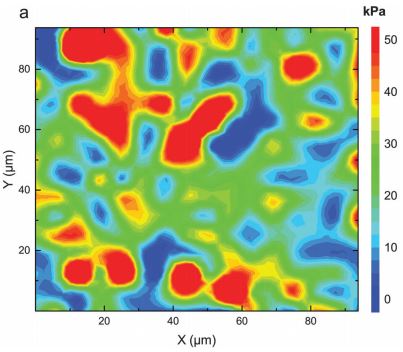The composition of the human body varies widely in rigidity from soft organs and fat to stiff bones. The rigidity and stiffness of the body plays vital roles in cell behavior and tumor development, so measuring and understanding tissue stiffness is important for the design of biomaterials and cancer treatment.
In a recent Soft Matter article, a multidisciplinary group from Grenoble, France, has probed the elastic modulus of the brain, specifically the pituitary gland, which produces and regulates hormones. Unlike previous attempts, which have observed tissues at the macro scale (mm, cm), the research team has investigated the brain at the micron level.
At this subcellular scale, it was revealed that the tissue was not uniform in elasticity and there were vast differences in stiffness throughout the gland. Using atomic force microscopy (AFM), rigidity measurements from 1 kPa to 50 kPa were recorded with localized islands of increased stiffness observed.
This has been the first attempt to measure elasticity of the pituitary gland at the micron scale, providing research that could help understand cellular organization and the mechanism of tumor growth in the brain.
Interested in this research? Read the full article for free until 03/07/2016 using a registered RSC account:
AFM mapping of the elastic properties of brain tissue reveals kPa μm-1 gradients of rigidity
Nicolas Bouchonville, Mikaël Meyer, Christophe Gaude, Emmanuel Gay, David Ratel, and Alice Nicolas
Soft Matter, 2016,12, 6232-6239
DOI: 10.1039/C6SM00582A
—————-
Dr. Morgan M. Stanton is currently a postdoctoral researcher at the Max Planck Institute for Intelligent Systems in Stuttgart, Germany. Her research focuses on the cell-material interface material and properties regulating cell behavior.
Read more about Morgan’s research publications and follow her on Twitter: @morg368.












